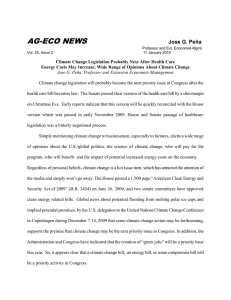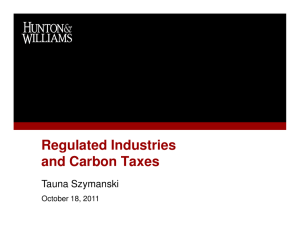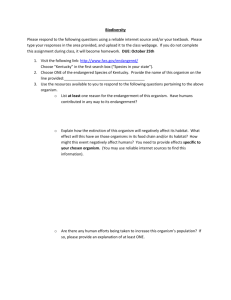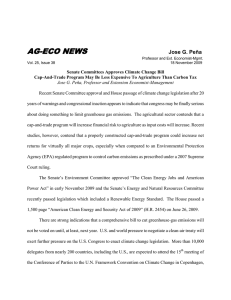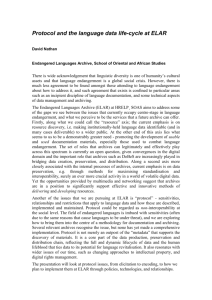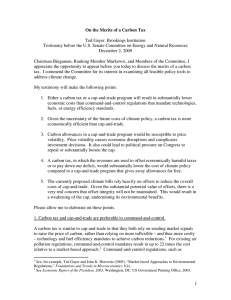Cap - and Trade and
advertisement
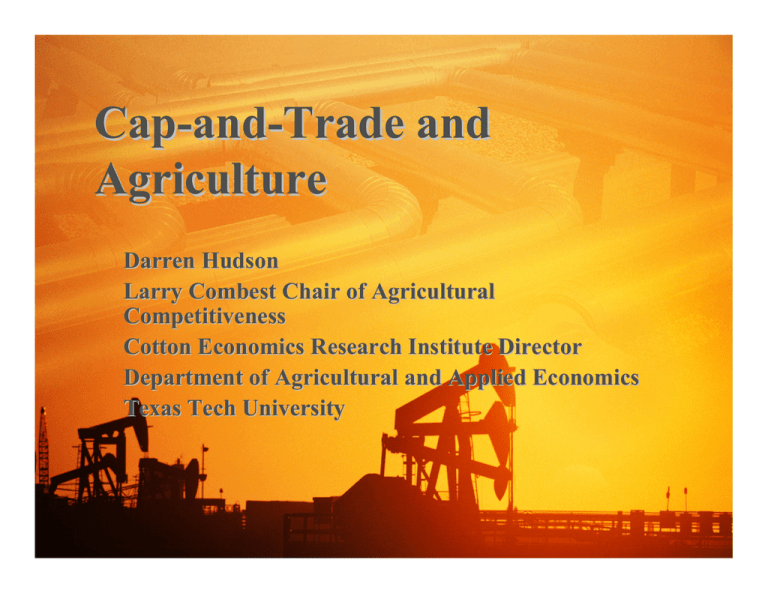
Cap-and-Trade and Agriculture Darren Hudson Larry Combest Chair of Agricultural Competitiveness Cotton Economics Research Institute Director Department of Agricultural and Applied Economics Texas Tech University The Issues • Two Issues Running in Parallel – – Endangerment Finding Legislation (Cap-and-Trade) • Some believe Endangerment finding is designed to force legislation to pass. Cap-and-Trade Carbon Emissions Carbon Offsets Cap Carbon Output Purchase offsets from outside industry to compensate for carbon output Trade between firms from more to less efficient Two Potential Components of “Climate Control” Markets Climate Climate Control Control Markets Markets Cap-and-Trade Cap-and-Trade Market Market Offset Offset Market Market While these markets can, and often do, work in conjunction, they do not necessarily need to be together. Most typically, we see offset markets without cap-andtrade. Cap-and-Trade Assumptions • CO2/GHG emissions are a problem and should therefore be regulated • Caps are binding for some, not for others, offering opportunities for trade (otherwise, we just have a regulated reduction) • Technology exists to lower CO2/GHG emissions such that adopting firms can remain under caps and trade to compensate for investment costs • The cap-and-trade market can be effectively administered on a national scale • Everyone else follows our lead and reduces carbon emissions as well EPA Assessment of Cap-andTrade • Cap-and-trade slows growth in energy demand – Current projected energy demand without capand-trade for 2015 would not be achieved until 2030 (higher prices…no surprise here) • Energy offsets must range between $13 $17/mt CO2 to induce offset production – Must use international offsets to achieve needed abatement—much of the offset benefit would be going to foreign countries • If the tax/offset revenues are not returned to American households, cost estimates would increase substantially Heritage Foundation Report • Heritage Foundation estimates added energy costs to American households of around $1,870/family/year – As backloaded effects kick in, energy cost increase goes to $6,800/family/year (2035) Marshall Institute Estimates % Change from Baseline GDP 2015 2030 2050 -0.14% to -3.30% -0.26% to -5.90% -0.82% to -10.10% Cap-and-trade projected to produce drag on economic growth over the present – 2050 period. Ag Effects--FAPRI 1,900 Acre representative Missouri farm; 798 acres corn, 1,007 acres soybeans, and 95 acres wheat Estimating Effects-Complications Electricity Truck Manufacturing Gin Trucks Gin Machinery Cost of Ginning Gin Administration Offsets • Agriculture initially seen as a source of offsets – Offset is an allowance for carbon sequestered or reduced carbon output due to adoption of a production practice or crop – Farms could sell these offsets in a secondary market – The purest offset to date for this area, grassland, results in 0.5 mt/CO2 per year • Offsets would likely come after initial costs of cap-and-trade felt, if at all Endangerment Finding • Endangerment Finding – In Response to Supreme Court Ruling in Massachusetts versus EPA – Proposes that six compounds • Are emitted from Automobiles in enough quantity to cause a danger • Only four of the compounds actually come from autos Endangerment Finding • Endangerment Finding – This is the first endangerment finding that is proposed based on indirect effects • Actual level of CO2 not a direct issue • Effect of CO2 on climate is the issue Endangerment Finding • Endangerment Finding – – First finding affects automobiles Primary Targets probably include • Power Plants • Oil Refineries Endangerment Finding • If Endangerment is Found – Someone may sue during a permit action to say that CO2 should be in stationary source permits – Typical Cotton Gin Emissions (thanks to Kelly Green at Texas Cotton Ginners for this example): • 40 Tons PM10 • 3 Tons – All Other Compounds • 3,000 Tons of CO2 Endangerment Finding • • Current Permit Fees are about $150 - $300 per Year Title V Fees are $32/Ton Each year – This fee kicks in if your emissions are over 100 tons/year (A saving grace of the Waxman-Markey bill is that it sets the threshold at 25,000 tons, which would exempt most agribusinesses) – With CO2 Figured in, emission fee would be $97,000 per year • This is why some believe legislation must pass Conclusion • Significant downside risk to agriculture through higher energy and input costs • Limited upside potential through offset markets • Questionable whether a workable version of cap-and-trade can be implemented at the national level • Endangerment finding could force the issue in directions with less legislative controls
